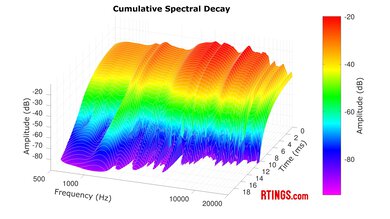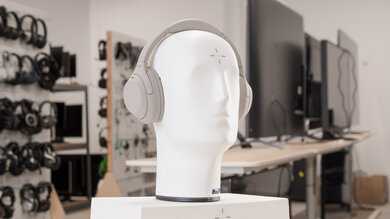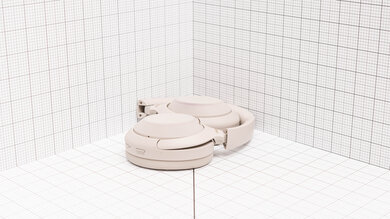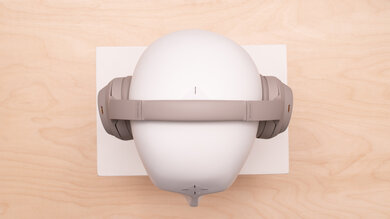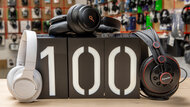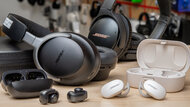The Sony WH-1000XM4 Wireless are the successor to the Sony WH-1000XM3 Wireless. This generation has some improvements, including a longer continuous battery life, additional touch-sensitive control features, and multi-device pairing. Like their predecessor, they have an outstanding noise isolation performance thanks to their noise cancelling (ANC) feature and a comfortable, premium-looking design. Overall, these decently versatile headphones are a solid choice for many different listeners, and even though Sony replaced them with the Sony WH-1000XM5 Wireless, they're still worth checking out as a comparable alternative.
Our Verdict
The Sony WH1000XM4 aren't the best choice for sports use. They're comfortable and well-built but don't stay on your head during more intense exercises. Plus, their closed-back design isn't the most breathable, and since they trap in some heat, you're prone to sweating more than usual with them on.
- Comfortable fit.
- Over 37-hour continuous battery life.
- Can fall off your head with moderate movement.
- Bulky design.
The Sony WH1000XM4 are great for commuting and travel. While they aren't the most portable headphones, their hard carrying case helps protect them while you're on the go. They have over 37 hours of continuous battery life, and you can comfortably wear them for long listening sessions without much fatigue. Also, their ANC can block out bass-heavy sounds like the rumble of engines as well as mid-range sounds like commute chatter, meaning you can enjoy your music without distraction.
- Comfortable fit.
- Incredible ANC performance.
- Over 37-hour continuous battery life.
- Bulky design.
The Sony WH-1000XM4 are very good for office use. Thanks to their ANC feature, these headphones block out a lot of distracting background noises, like chatter from nearby coworkers, so you can focus on your work. They last over 37 hours continuously, and their comfortable fit isn't fatiguing over long periods at your desk. That said, they leak a bit of audio at loud volumes, so you'll want to keep the volume low to avoid bothering your coworkers.
- Comfortable fit.
- Incredible ANC performance.
- Over 37-hour continuous battery life.
- Bulky design.
The Sony WH1000XM4 are compatible with Bluetooth-enabled PCs, but their latency is likely too high to be suitable for wireless gaming. You also can't use them wirelessly with PlayStation or Xbox consoles.
The Sony WH-1000XM4 are good for wired gaming. Thanks to their 1/8" TRS cable, you can connect them to your PC, PlayStation, and Xbox consoles, but you can't use the microphone using this connection. That said, they have a comfortable fit for long gaming sessions, and their bass-heavy sound profile adds an extra punch to explosions and action-packed scenes.
- Graphic EQ and presets.
- Comfortable fit.
- Audio-only wired connection.
The Sony WH1000XM4 are very good when it comes to audio reproduction accuracy. Their warm sound profile pumps up the bass frequencies relative to our target curve, but the frequency response generally follows this sound profile without significant deviations. The L/R drivers are well-matched, indicating tight tolerances, and harmonic distortion levels are low enough that you won't notice any coloration of your audio at higher volumes. The low group delay across the entire frequency range also means that transients in the bass-range are precise and tight, while the treble range is smooth and transparent.
The Sony WH-1000XM4 are outstanding when it comes to noise isolation. They excel at blocking out external noise across the entire frequency spectrum, though bass-range noises like rumbly plane engines are particularly heavily attenuated. They can leak a bit of audio, but this is unlikely to be noticed unless you're blasting your tunes in a very quiet place, like a library.
The Sony WH1000XM4 have a disappointing microphone performance. While your voice will be understandable, it'll sound thin and muffled for the most part. The mic also struggles to isolate your voice from your surroundings, particularly in busy backdrops.
The Sony WH-1000XM4 have great frequency response consistency. While they're prone to small inconsistencies in the high-mid and treble range, you should be able to achieve consistent audio delivery, as long as you take the time to ensure a solid fit.
Performance Usages
Changelog
- Updated Jul 15, 2025:
This review has been updated to Test Bench 2.0, which adds the following tests: Stereo Mismatch, Group Delay, Cumulative Spectral Decay, PRTF, Harmonic Distortion, and Electrical Aspects. We've also added new performance usages and updated the text throughout the Sound tests.
- Updated Jul 10, 2025: We've converted this review to Test Bench 2.0, which updates our sound tests and adds performance usages. You can read more about this in our changelog.
- Updated Dec 13, 2024:
We updated the ANC Wind Handling section of this review after re-testing these headphones with the wind reduction feature turned on.
- Updated Nov 25, 2024:
Several Sound tests have been updated following TB 1.8. There have also been text changes made throughout the review, including the usages and product comparisons to match these results.
Check Price
Differences Between Sizes And Variants
The Sony WH-1000XM4 come in two different color variants: 'Black' and 'Silver'. We tested the Silver model, and you can see its label here. These headphones also come in 'Midnight Blue', which are exclusive to Best Buy, and in a limited edition 'Silent White' color scheme to celebrate Sony's 75th anniversary. The 'Silent White' variant and their included accessories, like their carrying case and cables, are stark white with gold accents. They were only available from May through August 2021.
If you encounter another variant, please let us know in the forums, and we'll update our review.
Popular Headphones Comparisons
The Sony WH-1000XM4 are premium noise cancelling headphones and are the successor of the Sony WH-1000XM3 Wireless. They're also the previous generation of the Sony WH-1000XM5 Wireless. They're more comfortable and portable than the XM5, have more voice prompt options, and have a comparable bass-heavy default sound profile. Compared to their rival, the Bose QuietComfort 45/QC45 Wireless, they aren't as comfortable or neutral-sounding but have a better ANC performance and more robust customization options.
If you're looking for other headphones, see our recommendations for the best noise cancelling headphones, the best closed-back headphones, and the best travel headphones.
The Bose QuietComfort Ultra Headphones Wireless and the Sony WH-1000XM4 Wireless are both high-end headphones, and depending on your needs, you may prefer either pair. Both headphones have fantastic ANC systems, so you'll get top-tier noise isolation from either pair. The Bose are more comfortable and have a better-performing mic. They also support aptX Adaptive, which is a codec that automatically adjusts its performance based on your audio content, so you'll be able to listen to audio in higher quality or, if you're streaming video, reduce lip sync mismatch. The Sony headphones support passive playback and LDAC codec, allowing you to stream higher-quality audio than with the default SBC codec.
The Sony WH-1000XM4 Wireless are better over-ears than the Sony WH-CH720N Wireless. The WH-1000XM4 are more comfortable and better built, and their ANC can block out significantly more ambient noise across the range. They also support LDAC, which is good if you want to stream high-res audio. However, the WH-CH720N have a better overall mic performance.
The Sony WH-1000XM4 Wireless have a slight edge over the Sennheiser MOMENTUM 4 Wireless due to the better noise isolation on the Sony. While both are premium headphones, the Sony are a bit more comfortable; their ANC blocks out more ambient sound, and they support LDAC, which is a Bluetooth codec for streaming high-quality audio. They also have a virtual soundstage feature to help make your audio seem more immersive and spacious. However, the Sennheiser are no slouch: they also have a much longer continuous battery life, and they support aptX Adaptive, which is a Bluetooth codec that dynamically adapts to your audio content to give you either lower latency or better audio quality. If you want USB audio, only the Sennheiser boast that feature, but their ANC isn't as strong as the Sony.
The Sony WH-1000XM5 Wireless are the next generation of the Sony WH-1000XM4 Wireless. There have been a couple of changes in design and performance. As a result, the XM5 have a better microphone performance, and the ANC system attenuates noise slightly differently; you can still expect significant ambient sound isolation from either pair of headphones. However, the XM5's build isn't as solid as the previous generation, and the ANC has a harder time blocking out the low rumble of bus engines. Additionally, their automatic adaptive ANC system can't be disabled.
Test Results

The Sony WH-1000XM4 have a warm sound profile that adds some thump and punch to your mixes. You can switch up their performance to your liking using the graphic EQ and presets in their companion app, though it's not easy to adjust for the emphasis in the high-bass to the low-mid since the adjustment bands start at 400Hz. These headphones sound a little different with ANC turned on or off.
These headphones have great frequency response consistency. The bass range is very consistent across different users, possibly because their noise cancelling feature seems to check for bass consistency. However, their fit and positioning on your head can lead to some inconsistencies in the high-mid to the treble range. Once you get a good fit, you'll achieve a more consistent sound each time you use them.
The Sony WH-1000XM4 have good bass compliance. The response is boosted, resulting in an intense thump, punch, and boom that's suitable for genres like EDM and hip-hop. In songs like 'King Kunta' by Kendrick Lamar, the boosted low-bass makes the mix overly rumbly and boomy, which muddies the vocals in the chorus.
The mid-range target compliance is excellent. The response is pretty neutral and well-balanced across the range, so vocals and lead instruments are clear, accurate, and present. However, a small bump from the boost in the bass range continues in the low-mids, making your mix sound less clear overall. We also noticed a minor mismatch between the left and right drivers, which can also be seen in stereo mismatch. However, this may be unique to our unit, and yours may perform differently.
The Sony WH-1000XM4 have great treble compliance. A slight under-emphasis in the low-treble can make vocals sound a touch distant at times, but there's enough mid-treble present that this isn't really an issue: voices have plenty of detail and presence. That said, the mid-treble is a little inconsistent, so sibilants can sound alternately dull or piercing depending on their pitch.
These headphones have very good peaks and dips performance, indicating they control their sound profile well. The bass and low-mids are virtually flat, but from the upper-mids on up, the sound is less consistent. Voices can sound distant or present depending on the notes sung. This is most noticeable in the mid-treble region, where sibilants and cymbals are rendered dull or piercing depending on their pitch.
These headphones have an excellent stereo mismatch performance. The L/R drivers are very well-matched when it comes to amplitude and frequency, though there are some slight mismatches in the upper-mid range and beyond. There are some slight deviations in the phase response too, in similar frequency bands, though they aren't audible in real-life content.
These headphones have an excellent group delay performance. Group delay is below the audibility threshold across the entire frequency range, resulting in tight bass and transparent highs.
As is often the case with closed-back headphones, their PRTF performance is poor. They're unable to create a sense of space, sounding small and as if sound is coming from inside your head rather than from speakers placed in the room around you.
These headphones have a good harmonic distortion performance. At both regular and elevated listening levels, distortion is minimal, and there's no audible coloration, regardless of how loud you play back your audio.
These headphones support 360 Reality Audio, which can improve audio quality. It offers a feature that analyzes your unique ear shape to create a more spacious sound. However, you need to subscribe to services like Tidal or Nugs.net and use compatible audio files, which limits the feature's practicality.
Additionally, you can buy a WLA-NS7 transmitter if you want to connect the headphones to compatible Sony BRAVIA TVs. While the experience is immersive compared to Bluetooth, the sound profile falls flat of a home theater system, feeling lackluster with the Quality Limiter turned on or off.
These are the test settings we used with these headphones. Our results are only valid with these settings.
The Sony WH-1000XM4 have a very similar design to their predecessor, the Sony WH-1000XM3 Wireless. These over-ears have a matte finish with the manufacturer's logo on the yokes in gold. They come in three different color variants: 'Black', 'Silver', and 'Midnight Blue', which is exclusive to Best Buy. The all-white colorway, 'Silent White', was only available in 2021 for Sony's 75th anniversary.
The Sony WH-1000XM4 are very comfortable headphones. The lightweight foam earpads don't put much pressure on your head, so you can wear them for a long time without feeling much fatigue. However, they are shallower in profile than the Bose QuietComfort 45/QC45 Wireless, which can present discomfort if you have larger ears, as your ears may rub against the driver housing.
The Sony WH-1000XM4 have good controls. They have a touch-sensitive surface on the right ear cup and two physical buttons on the left ear cup. The 'Custom' button on the left ear cup controls the noise cancelling feature by default but can also be configured via the app to activate a Speak-to-Chat function. It pauses your audio and lets in ambient sound as soon as you start talking. Note that the ANC turns off by default when you're on a call, and the headphones enter 'Talk-Through' mode. Luckily, you can cycle back to ANC by pressing the custom button.
Their touch-sensitive surface is very similar to the Sony WH-1000XM3 Wireless. It's somewhat easy to register accidental inputs to the touch controls when readjusting the headphones, though. Also, the controls feature more voice prompts than the Sony WH-1000XM5 Wireless, making them a better option for users looking for a more interactive experience.
On the left ear cup:
Power button:
- Press and hold: Turns headphones on or off. If you continue to hold this button past turning the headphones on, you'll enter Bluetooth pairing mode.
Custom button:
- One press: Cycles between ANC on, talk-through mode, letting you better hear your surroundings without taking off the headphones, and ANC off. You can remap this control via the companion app to activate Alexa or Google Assistant.
The touch-sensitive surface on the right ear cup:
- Double tap: Plays and pauses audio. Also answers and ends a call.
- Swipe forward: Skips to the next track.
- Swipe forward and hold: Fast forwards through your track.
- Swipe backward: Skips to the previous track.
- Swipe backward and hold: Backtracks through your track.
- Swipe up: Turns the volume up incrementally.
- Swipe down: Turns the volume down incrementally.
- Cover the ear cup with your palm: Enters talk-through mode.
These over-ears aren't the most portable. They're the same size as the Sony WH-1000XM3 Wireless, and like most over-ears, they have a bulky design. Fortunately, unlike the Sony WH-1000XM5 Wireless, you can fold these headphones to take up less space in your bag.
The Sony WH-1000XM4 come with a great hard carrying case. It comes in the same color as your unit, which is a nice touch. The case can help protect them from scratches, falls, and water damage. It's also much more compact than that of the Sony WH-1000XM5 Wireless, making it a better option for users on the go.
Their build quality is great. Their look and feel are very similar to the Sony WH-1000XM3 Wireless. Their build is mostly made of high-quality plastic that feels sturdier and more durable than their successor, the Sony WH-1000XM5 Wireless. While the headband is flexible, the combined yoke and hinge element seems prone to cracking over time.
These headphones have a fantastic full-range noise isolation performance. Their ANC performs slightly better in the bass range than their successor, the Sony WH-1000XM5 Wireless, which helps to further block out sounds like the low rumble of bus engines. The ANC can also cut down mid-range noise like voices and higher-pitched noise like the hum of an AC unit. If you want to make a call while using the ANC, the headphones go into 'Talk-Through' mode by default, letting you better hear your surroundings. You can cycle back to ANC mode (or turn 'Talk-Through' off) by pressing the custom button on the left ear cup.
Unfortunately, some users have reported issues with the ANC system producing a high-pitched noise from one driver, which is quite unpleasant. Although we didn't experience this with our unit, please let us know in the forums if you've encountered this issue.
When it comes to more dynamic environments, these headphones also deliver a fantastic noise isolation performance. They can reduce a lot of rumbly airplane noise, which is handy when traveling. They offer similar isolation when it comes to typical office sounds and a slight improvement when it comes to the ambient hum of traffic on a busy street.
If you're walking outdoors, chances are you'll encounter wind noise. It's unwanted sound produced by the ANC system; wind interacts with its microphones, so the ANC tries to cancel this sound out by playing anti-noise. However, this wind sound doesn't really reach your ear. What you're left with is the sound of anti-noise. These headphones have a wind reduction mode that aims to reduce anti-noise artifacts. You access it by activating Ambient Noise (transparency) mode and then moving the in-app slider one notch to the right. With this feature activated, these headphones do a reasonable job of reducing wind noise. You'll still hear rumbly artifacts when the wind blows against the headphones, but noise from the mid-mids up through the treble range is attenuated well.
They have a satisfactory leakage performance. Leakage is most notable in the mid range and sounds full-bodied. If you listen to audio at high volumes, others will hear parts of your audio. However, the average amount of noise in an office setting is loud enough to help drown out most of your escaping audio.
The Sony WH-1000XM4 have an integrated microphone. If you're looking for wireless over-ear headphones with a boom microphone, consider the Jabra Evolve2 85 Wireless.
The Sony WH-1000XM4's mic has a passable recording quality. Your voice sounds thin, muffled, and lacking in detail to whoever is on the other end of the line.
Note: Our recording file lags and skips in a few areas. It's a known bug in our testing process. We don't know what causes the lag, but we don't expect users to encounter this issue.
The microphone has a disappointing noise handling performance. Loud sounds like a busy street or a train pulling into the station can drown out your voice, so you won't be heard clearly. If you need to take an important call, it's best to do so in a quiet environment like home.
The Sony WH-1000XM4 have excellent battery performance. The manufacturer advertises them to last 30 hours continuously with their ANC on. Still, we measured over 37 hours, which is longer than the Sony WH-1000XM5 Wireless and will easily last through long trips without needing a recharge. That said, it's worth noting that battery life varies depending on your usage and active features like the ANC or mic can drain the battery quicker. If you're worried about battery life, the headphones have an auto-off timer to conserve battery life if you forget to turn them off, as well as a smart pause feature, which automatically pauses your audio if you remove the headphones from your head. You can even use them passively via their 1/8" TRS cable, but you won't be able to use their mic.
The Sony | Headphones Connect app offers lots of additional features. For example, you can customize the sound with the graphic EQ and presets. Also, the app lets you adjust the auto-off timer, remap the control, and see which devices you have connected to the headphones at a given time. You can access other features like Smart-Pause, which automatically pauses your audio when you take the headphones off your head, and Sony's 360 Reality Audio feature.
The Sony WH-1000XM4 come with a 1/8" TRS cable, which allows you to use the headphones passively and receive audio. While this connection doesn't support mic audio, it has negligible latency, so your audio and visuals stay in sync if you're watching videos.
The Sony WH-1000XM4 have excellent Bluetooth connectivity. They support Bluetooth 5.0 and are NFC-compatible, making them easy to pair with Android devices. Unlike the Sony WH-1000XM3 Wireless, they can pair with up to two devices simultaneously, which is convenient. Unfortunately, they have high latency on PCs via SBC. As a result, this codec isn't the best choice for gaming or watching movies on your computer, though some apps and devices compensate for latency.
These headphones also support Sony's proprietary hi-res codec, LDAC, which offers better audio quality over Bluetooth. They have high latency via this codec, which is expected for streaming higher-quality audio. However, this won't be much of an issue if you only stream music. If you're looking for a pair of noise cancelling headphones with an H1 chip to seamlessly pair with Apple devices, consider the Apple AirPods Max Wireless.
You can use the Sony WH-1000XM4 wirelessly with Bluetooth-enabled PCs. You can also use them via an analog connection, but they can only receive audio, so you can't use their mic.
These headphones can only receive audio when you wire their 1/8" TRS cable into your PS4 or PS5 controller's audio jack.
You can plug these headphones into your Xbox One or Xbox Series X|S controller using an audio cable, but you can only receive audio and can't use the microphone.

